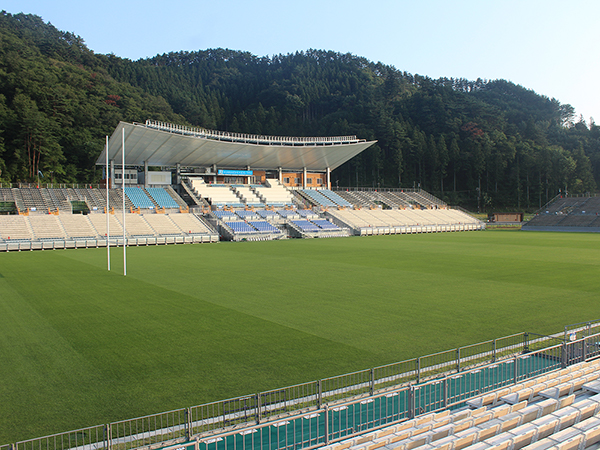Kamaishi, one of Japan’s rugby heartlands, has received its fair share of ill fortune over the past 10 years. Mother nature has dealt the 35,000-population city in Iwate Prefecture a series of cruel blows, from the devastation caused by the Great East Japan Earthquake of 2011, to the most recent destruction left behind in the wake of Typhoon Hagibis. It’s as though Kamaishi were cursed; a real-life Derry, Maine from Stephen King’s cult-horror classic, IT.
While Hagibis didn’t pose quite the same threat to life that the events of 3/11 did, it forced World Rugby to cancel the World Cup game between Canada and Namibia at the Kamaishi Recovery Memorial Stadium. In a city that has used rugby as a central theme of the post-disaster reconstruction efforts, it feels like jagged rock-salt being scraped across an open wound. One’s thoughts have to go out to people of Kamaishi who just can’t seem to catch a break.
https://twitter.com/fraserjapan/status/1183204779670921217
Rugby: A Guiding Light
As someone who loves this sport, it pulls on my heartstrings to see a city use rugby as a guiding light through the dark passages of adversity. Yurie Endo, director of Kamaishi’s Rugby Café – an organization run by the citizens of the town designed to educate people about the spirit of rugby and the 2019 Rugby World Cup – said, “[Rugby] is part of our identity. It’s in our DNA.”
This statement rings true in every sense; rugby has been baked into Kamaishi’s core for 60 years. From the Fuji Iron & Steel Kamaishi Rugby Club of the 1960s to the irrepressible “Northern Iron Men” squad of the 1970s and ‘80s who won seven back-to-back All-Japan Rugby Football Championships to the rebranding of the team as the Kamaishi Seawaves in 2001 – a club run by and for the people – this quiet town in northern Honshu has remained a true stronghold of the sport.
The crowds came out in support of the opening of Kamaishi Recovery Memorial Stadium, as local team Kamaishi Seawaves Rugby Football Club faced Top League side Yamaha Júbilo #RWC2019 pic.twitter.com/JJVpZbW0zl
— Rugby World Cup (@rugbyworldcup) August 19, 2018
The decision to build the Recovery Memorial Stadium following the earthquake and tsunami of 3/11, and to bid for it as a 2019 World Cup venue, was part of the town’s Reconstruction Master Plan. On November 2, 2017 Kamaishi was officially confirmed as a World Cup host-city.
When I visited Kamaishi this past August, a local representative told me the stadium “marks the huge strides we’ve taken since the earthquake and the fresh start we envisioned in our recovery.”
Following torrential rains in north-east Japan last night, today's #NAMvCAN at #RWCKamaishi has been cancelled. This follows reports of localised flooding & landslides. Please do not travel to Kamaishi or the match venue as it will be closed. https://t.co/RHfEJymIZF
— JAPAN RUGBY LEAGUE ONE (@LeagueOne_EN) October 12, 2019
One Step Forward, Two Steps Back
Typhoon Hagibis’ wrath left many a sobering Rugby World Cup tale behind. After World Rugby’s much maligned decision to cancel several games from the final weekend of the competition’s pool stages – ostensibly on safety grounds – these stories broke forth much like the banks of the Tama River in the thrall of the typhoon.
Thoughts were spared for Italians Leonardo Ghiraldini and Sergio Parisse, whose glittering careers were ended on the training pitch after the final pool stage clash with New Zealand was canceled. Yet, Canada vs Namibia’s cancelation may be the most poignant story of all. It was the second of two games to be played at the Recovery Memorial Stadium, set to take place on Sunday, October 13.
Match between Namibia and Canada in Kamaishi has been cancelled. The team and staff are safe and on lock down till the City and Prefecture advises otherwise.
Thanks for the support in Namibia's journey to the World Cup and throughout the tournament. https://t.co/gvs2eD2FFb— Namibia Rugby (@namibia_rugby) October 12, 2019
Typhoon Hagibis, which at one stage had reached level 5 super typhoon status, zipped through Kamaishi in the early hours of Sunday morning, causing widespread flooding and landslides. The Recovery Memorial Stadium’s location, enwreathed by hills, makes it more prone to landslide damage than stadiums built in cities. On Sunday morning, World Rugby canceled the game due to safety concerns.
Now, the question is: Why was there no contingency? Simply moving the game to another stadium wouldn’t necessarily appease the Kamaishi locals, but the idea that it could not be rescheduled for another date, to give the people of this apparently luckless town the kind of spectacle they deserve, seems like nothing short of a vast oversight. World Rugby have stuck to their guns with regards to pre-tournament rulings on permutations in the event of match cancelations, when it seems like a bit more malleability in their decision-making would have benefitted fans, players and tournament organizers alike.
Following the cancellation of their match in Kamaishi, @RugbyCanada players headed out to help with recovery efforts, showing the true values of the game.
Amazing scenes and brilliant to see from the team. #RWC2019 pic.twitter.com/jdXQlyD2ZM
— Rugby World Cup (@rugbyworldcup) October 13, 2019
A Canadian Clean-Up
Following the news of the game’s cancelation, the Canadian team and traveling fans were rightly disappointed, especially given that the encounter was one their head coach, Kingsley Jones, felt they “would have won.” But what followed the decision was a gesture of highest class from the Canadian players.
Videos immediately swept the web showing the Canada team removing debris, shoveling dirt into bags, and helping to remove excess water in flooded and damaged areas. Kamaishi locals were quick to express their gratitude to the players, showing that this simple gesture has not gone unnoticed.
Paddy Watson, Canadian native and current Tokyo resident, helped out with his nation’s rugby team during Sunday’s clean-up. Paddy, a teacher at Bunka Suginami Canadian International School, is a member of the Canadian Chamber of Commerce Team Canada Committee – an organization set up to develop ties between Canada and Japan using rugby as a springboard.
Paddy tells me, “Because we were going to be playing there, we wanted to build a legacy between Canada and Kamaishi, to help them out in whatever way we could; hence the slogan ‘Support Kamaishi’ which is printed across our T-shirts.”
Canada team helped local people clean up a mud messy road after the strong typhoon. We really appreciate it. After that they enjoyed spend some time with local people! Welcome to Kamaishi. We’re hoping that you are coming back again!
##RWC2019 #RWCKamaishi #Canada #Kamaishi pic.twitter.com/y9SJhP0ZGo
— 釜石鵜住居復興スタジアム (@kama_stadium) October 13, 2019
Paddy says the decision to help out the locals came from Tyler Ardon, Team Canada’s captain. Not long after the Canadian players made the decision, they contacted Paddy and three of his fellow committee members asking them to help out. They duly obliged, and in spite of the destruction caused, there was “a lot of fun and smiles during the clean-up.”
“An 86-year-old local woman woke up in her home on Sunday pretty confused about what to do,” says Paddy. “A few hours later, she had a house full of Canadian rugby players in there helping her out.”
The Canadian clean-up came around the same time as their would-be opponents, Namibia, took to the streets of Miyako, Iwate to meet and greet the locals. Both teams’ actions embody the spirit of rugby and have brought joy, at least momentarily, to those who are in need of it. It’s great to see the 2019 Rugby World Cup having positive effects, beyond the realm of sports. At the very least, that’s part of the legacy this competition will leave to posterity.
THANK YOU 🇯🇵
Not how we wanted to end our #RWC2019 but a massive ありがとうございました 🙏 to the host nation & every community visited for the warmth & welcome given to us. Thank you for embracing rugby & its values 🏉🍁 #RugbyCA @rugbyworldcup @rugbyworldcupjp pic.twitter.com/CugcPPZM02
— Rugby Canada (@RugbyCanada) October 14, 2019
Feature photo of Canada locker room by David Ramos – World Rugby via Getty Images









